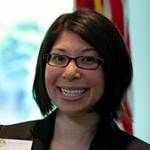To commemorate AAPIP’s 25 years of building a more democratic philanthropic sector, we asked you to help us identify 25 leaders who are making a difference in your local community and/or nationally. The 25 Leaders in Action honorees represent a diverse group spanning a wide range of organizations, years of experiences, roles and sectors. We invite you to learn about these outstanding leaders, their inspiring work and what keeps them going in our blog post series.
Romana Lee-Akiyama, Director of Grantmaking and Diversity & Inclusion, WOMEN’S WAY, and Philadelphia Chapter co-chair
1. Why are you passionate about advocating for AAPI communities?
Growing up in a mixed race family, I always have been keenly aware of race. As a daughter of a Chinese immigrant father, I grew up with very strong values, attitudes, and cultural ideals that resonated with an Asian American identity. But given the fact that I don’t obviously look like I belong to one race or another, I have often struggled to feel like I belong. My ability to traverse between and through cultural barriers, however, has given me access to opportunities and situations where I have seen actual discrimination and/or unconscious bias that exist against Asian Americans and other communities of color, and have been the recipient of it myself.
My father’s journey as a refugee in this country, and in all of the ways that he struggled, has driven my passion throughout the years to advocate for vulnerable low-income immigrants of color. My father invested everything he had (and didn’t have) to make sure that my brother and I could succeed. My father is nowhere near typical for a man of his background and generation– he is an artist and a professor. He believed in doing whatever you were passionate about, but being the best at whatever that was. He also did what was necessary to survive and make a living so that his children could live out their dreams. He and I had a slight rift when I was in college at a time when I decided that I didn’t want to be a doctor. Many Asian immigrant parents want their children to go into fields that lead to financial stability and a clear pathway for career success. I thought this was driving my dad’s desires for me – but in actuality, he just wanted me to succeed in something he thought I enjoyed. But being a good parent, as I am now learning with my own small child, is about giving your children the tools and resources to develop into the best person they can be – no matter if they change their mind a hundred times.
My father and I have since moved on from the failed hopes of me becoming a doctor (although I sometimes have regrets), and at the end of the day, I know my father is proud of me for the professional choices that I have made, and the ways that I have tried to make life easier for him in his old age. Prior to my career in philanthropy, I worked in local and national AAPI organizations dedicated to housing, community and economic development so that my father and others who have crossed endless boundaries can live in a country that is worthy of them, and have unfettered access to opportunities for self-determination and a future they desire.
2. What do you believe are the most critical issues facing AAPI communities today?
Cultural preservation is an issue that is really near to my heart. One of the many things I have learned from the experiences of the Native Hawaiian community is that cultural preservation (including language, cultural practices, access to sacred and natural resources, and self-determination) is intrinsically tied to the overall well-being of a people group. To know where you come from is to know where you are going. For AAPIs, particularly as we remain longer and longer in the U.S., we grow further from where we have come from. Over time, we lose language. We are no longer able to tell the stories of our people. We become disconnected from the sending country, particularly if we have no more relatives overseas. When we raise our children, they may not understand the cultural values of their heritage. When we lose this sense of self, we may inherit other social problems that come from internalized oppression and the lack of replacement of cultural roots.
Ethnic neighborhoods or communities such as Little Tokyo in Los Angeles, Japantowns, Chinatowns, Koreatowns and Manilatowns, Thaitowns, etc. all over the country have served as hubs for retaining cultural history. They have also served as centers for community building, supporting the social fabric of our broad AAPI landscape, and have been the gateway for new immigrants by providing jobs, housing and other forms of support for those seeking economic stability. These cultural hubs have also been dying out and have been affected by gentrification and other urban renewal projects that drive out communities and disburse the cultural power that was once in these hubs. Other trends include the move out to suburb and exurb communities by AAPIs. Similarly, the cultural assimilation of second, third and fourth generation AAPIs may diminish the connectivity to a local ethnic community.
The concern is then how do growing communities of AAPIs remain connected to their heritage and roots so that we can move forward as strong and healthy communities. I wrestle with this question every single day as I think about myself, my personal and professional affiliations, and now particularly as I raise my pre-K daughter. How little children understand race and identity is also of utmost importance because we are now raising the future generation who will inherit this country, and will be one day in charge of undoing the damage that has been done, or rebuilding the future that we, as social justice leaders want to see – with justice for all. Identity development and how young children relate to one another that are different is critical in how we build a better world. AAPI children are often sidelined and treated either as the model minority, or treated as a problem if English is not their first language by educators. How AAPI children are supported and integrated into our schools needs to be challenged and re-imagined so that children of all backgrounds can succeed at life, not just in producing strong academic outcomes.
3. In what ways do you strive to address the unmet needs for AAPI communities?
When I entered into philanthropy four years ago, I had a mission. For the majority of my career, and for the reasons listed above, I had been passionate about advocating for AAPI communities. My knowledge, commitment to, and relationships in AAPI communities drove my actions to ensure that all communities were being represented and supported in local philanthropic grantmaking and initiatives. By engaging in internal and peer advocacy, helping to build knowledge and challenge stereotypes, and actively building grant portfolios that support marginalized populations including AAPIs, I have been making progress – even if slowly, and even if one grant at a time.
4. What keeps you inspired?
Staying connected to my roots and to community is critical. As a family, we participate in cultural activities and stay active in as many AAPI civic organizations as possible. This past year, my family and I participated in intergenerational taiko lessons. Parents brought their small children together to learn how to play taiko, and when the kids’ attention span reached maximum capacity, the adults would learn together. My favorite piece I learned is “Matsuri”, which means festival.
Staying active in AAPIP also keeps me inspired because I am professionally connected with other AAPIs who are in the field of philanthropy, and can problem solve and brainstorm together. I was fortunate enough to work with Peggy Saika for a few years while a chapter leader, and watching the way that she leads boldly with her identity reminds me to remain true to myself and never be afraid to talk about who we are.
Romana Lee-Akiyama enthusiastically joined WOMEN’S WAY as the Director of Grantmaking and Diversity & Inclusion Initiatives in June 2014. Romana is responsible for leading the grantmaking initiatives of the organization, including overseeing the Community Women’s Fund and WOMEN’S WAY Action Partners portfolios, as well as managing a technical assistance program for funded agencies. Romana possesses a unique blend of experiences in the nonprofit health and human services, philanthropic and community development sectors, having served for over 15 years in numerous management and leadership roles. Prior to joining the organization, Romana was the Director of Capacity Building at the United Way of Greater Philadelphia and Southern New Jersey, where she focused on strengthening the nonprofit sector in the region to be both impactful and sustainable. Romana started her career at the Philadelphia Chinatown Development Corporation, where she grew in her passion for advancing economic and racial justice in distressed neighborhoods and communities, and then carried her passion to the National Coalition for Asian Pacific American Community Development based in Washington, DC, where she served as their Deputy Director. Romana is the Co-Chair of the Philadelphia Chapter of Asian Americans/Pacific Islanders in Philanthropy, and is excited to support the diversity and inclusion efforts at WOMEN’S WAY. Her knowledge and experience in examining the intersectionality of race, gender and other differences in society is what she is most excited about in her role. Romana holds a B.A. from Tufts University in International Relations and both an M.S.S. and an Master of Law and Social Policy from Bryn Mawr College’s Graduate School of Social Work and Social Research.

